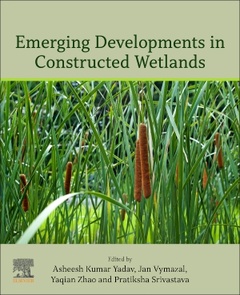Emerging Developments in Constructed Wetlands
Auteurs : Yadav Asheesh Kumar, Vymazal Jan, Zhao Yaqian, Srivastava Pratiksha

Section-I. New research experience with microbial assemblage, vegetation, substrate materials, pollutants, and wastewater 1. An overview of conventional and new approached in CWs, 2. Biofilms assemblages and biofilm formation in constructed wetlands and their role in the performance of CWs 3. An updated overview of plant species used in CWs 4. A global scenario of new substrates utilized in CWs 5. Role of animals in the function of constructed wetland for water environment protection 6. Fate of microplastics in constructed wetlands 7. Per- and polyfluoroalkyl substances treatment in constructed wetlands 8. Removal of priority substances and contaminants of emerging concern in CWs. 9. Emerging new techniques and tools for monitoring and analysis in constructed wetlands 10. Constructed wetlands for the treatment of cyanotoxins 11. Constructed wetlands for removing antibiotics and antibiotic resistance genes 12. Fate of metallic nanoparticles in constructed wetlands Section-II- Experience on New generation of constructed wetlands coupled with microbial electrochemical technologies 13. The emergence of constructed wetlands coupled with microbial electrochemical technology: historical development and the potential applications 14. Enhanced organic and nutrient pollutants in constructed wetlands coupled with microbial electrochemical technology 15. Large-scale implementation experience of constructed wetlands coupled with microbial electrochemical technology (METLAND system) 16. Biosensing of pollutants in constructed wetlands coupled with microbial electrochemical technology 17. Greenhouse gases emission control using constructed wetlands coupled with microbial electrochemical technology Section-III. New experiments with design, configuration, and layout 18. Modular and transportable constructed wetlands 19. Green wall and green roof constructed wetlands 20. New experiences to address the performance slowness in Constructed wetlands in a cold climate: some case studies 21. New Design and layout of floating wetlands 22. Evolution of constructed wetlands through modelling approaches 23. Stacking of multiple constructed wetlands units for enhanced treatment performance 24. Constructed wetlands based on Phytorid Technology for wastewater treatment application using lesser land footprint Section-IV. Performance Intensification of Constructed Wetlands 25. Aeration in constructed wetlands 26. Bioaugmentation in constructed wetlands for performance enhancement 27. French type CW-A way to intensify treatment performance 28. New experiences with traditional hybrid systems of two or more types of constructed wetlands 29. Hybridization of other technology with constructed wetlands for optimum performance 30. Full-scale verification of two-stage hybrid microalgal electroactive wetland-coupled anaerobic digestion-A case study 31. Biochar emended wetlands for enhanced pollutants treatment 32. New Designs and Operational strategies for intensification of treatment in CWs. Section-V. News Functions 33. Constructed wetlands in a new circular economy, resource-recovery oriented, and ecosystem services paradigm 34. Constructed wetlands as a Nature-based solution for wastewater valorization 35. A new role of wetlands in cities for water management in changing climate 36. Constructed wetland for wastewater treatment and?Salicornia?biomass production for JET fuel production 37. Secondary economic valuable functions of constructed wetlands beyond wastewater treatment
Jan Vymazal graduated from the Institute of Chemical Technology in Prague, the Czech Republic in 1980 and received a Ph.D. at ITC in 1985. Between 1985 and 1991 he was affiliated with Water Research Institute in Prague at the department of wastewater treatment. In 1991 Jan joined Duke University Wetland Center, North Carolina, the USA as a visiting scholar. During his stay at
Duke University until 1993, he focused on the wetland plant communities in Florida Everglades. Between 1994 and 2006 Jan worked as a freelance researcher focusing mostly on constructed wetlands for wastewater treatment.
In 2007, he joined the Faculty of Environmental Sciences at the Czech University of Life Sciences in Prague. He is currently a professor and Hea
- Contains recent updates of electroactive constructed wetlands development
- Provides updated knowledge gained with new substrates, newer plants species, new configurations, layout, etc.
- Includes information on a new type of wastewater, recently emerged pollutants, and performance intensification efforts
- Focuses on new functions of constructed wetlands along with wastewater treatment
- Discusses the positioning of constructed wetlands in the new paradigms of circular economy, nature-based solutions, and ecosystem services
Date de parution : 10-2024
Ouvrage de 800 p.



